Renal Failure Michele Ritter, M.D. Argy Resident –

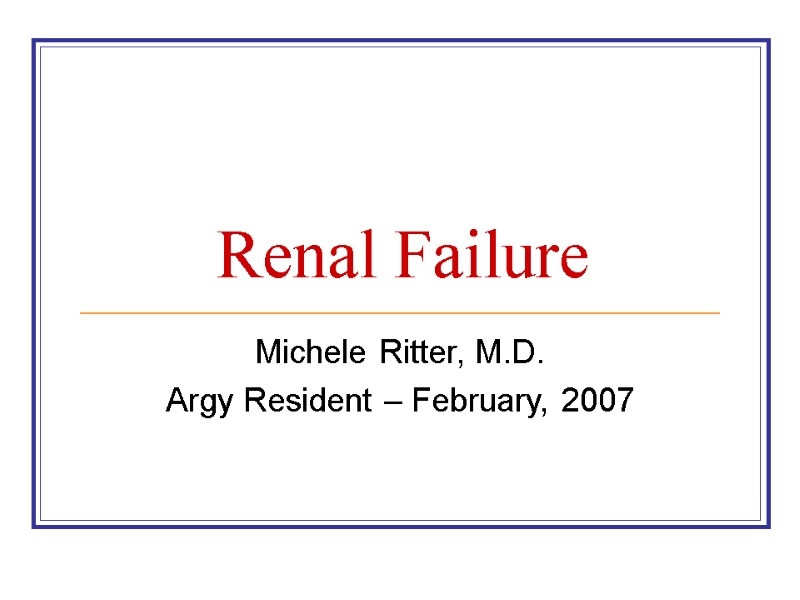
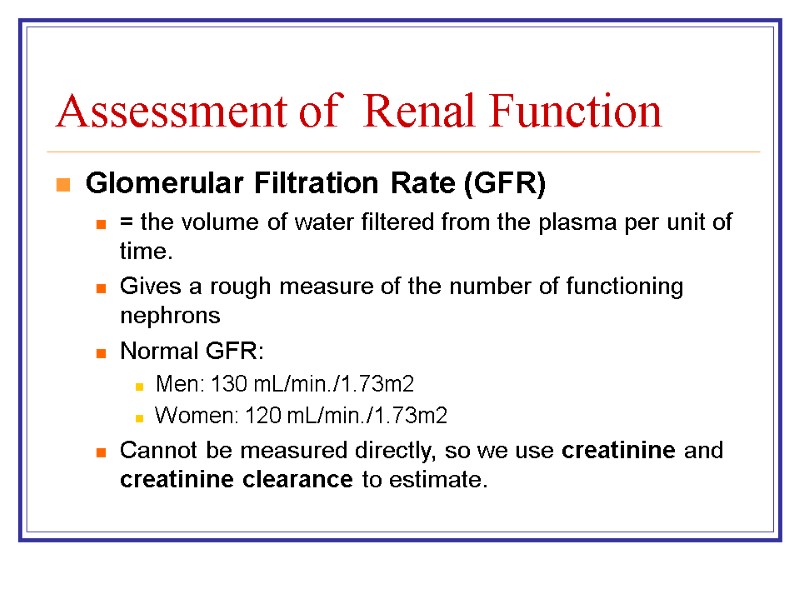
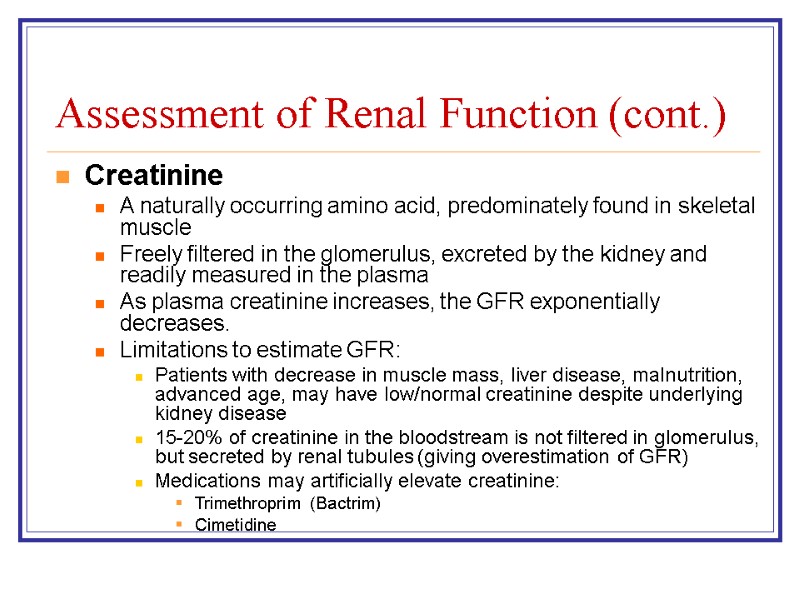
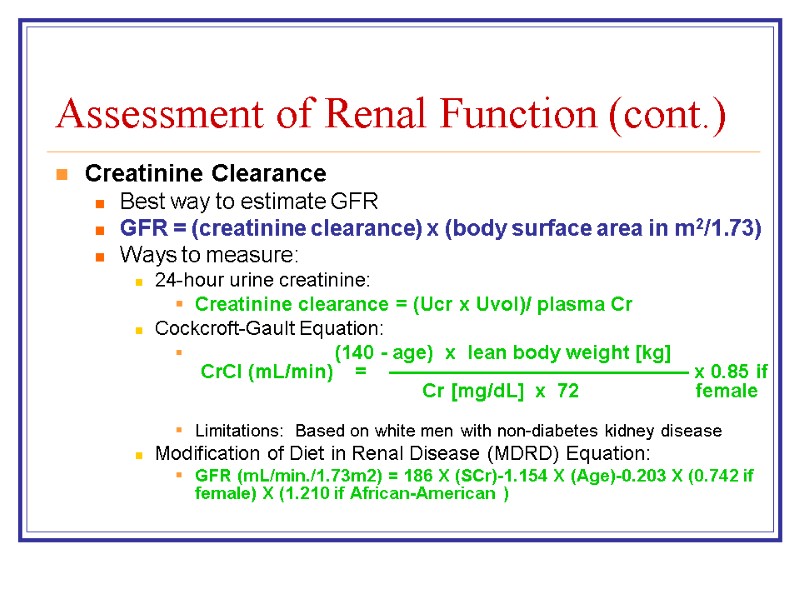
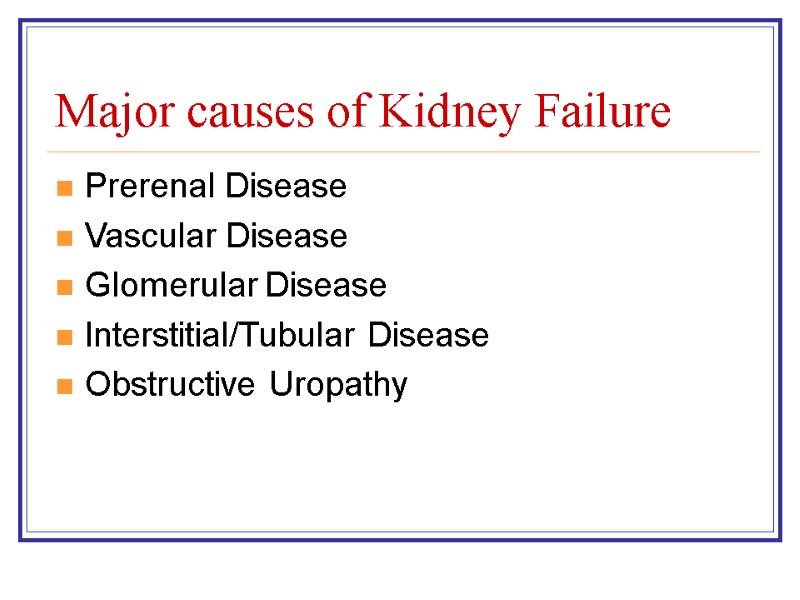
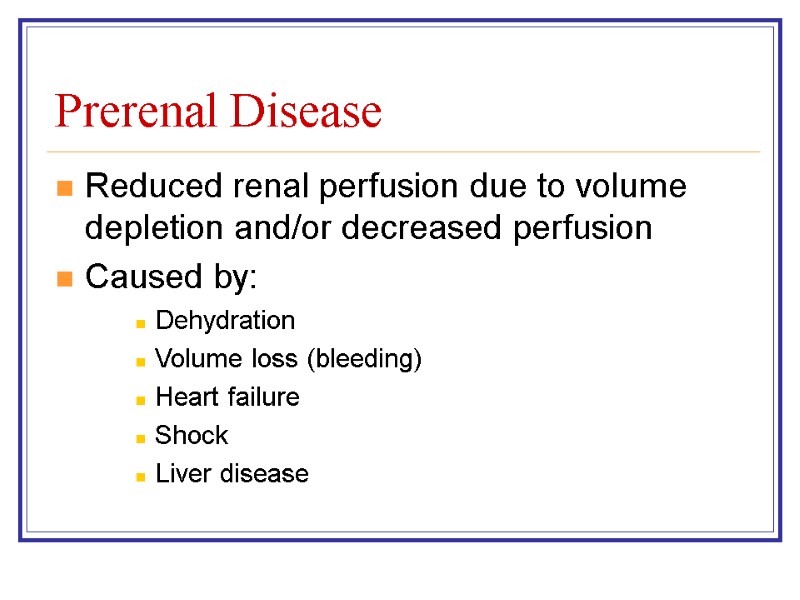
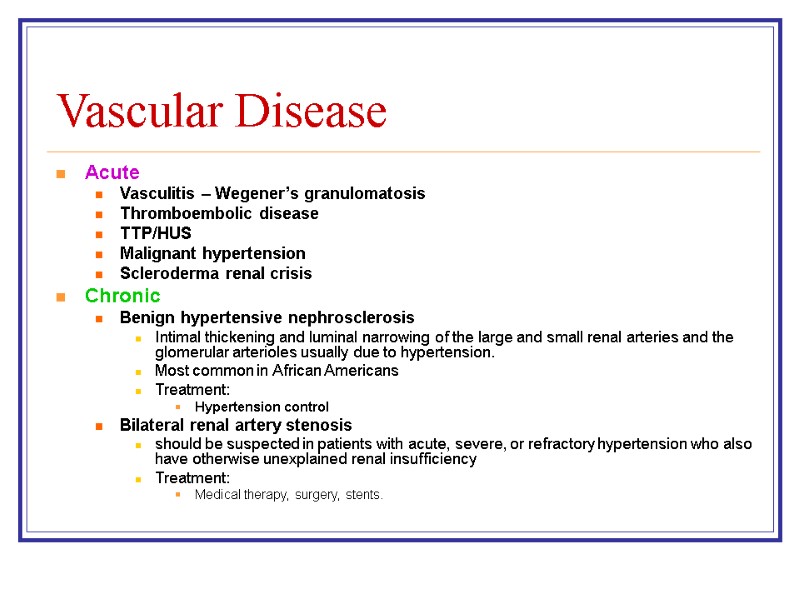

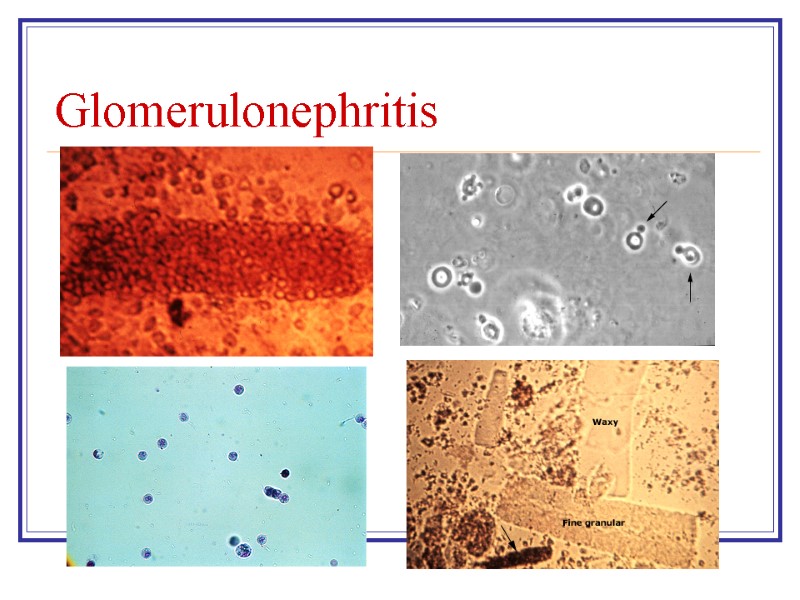
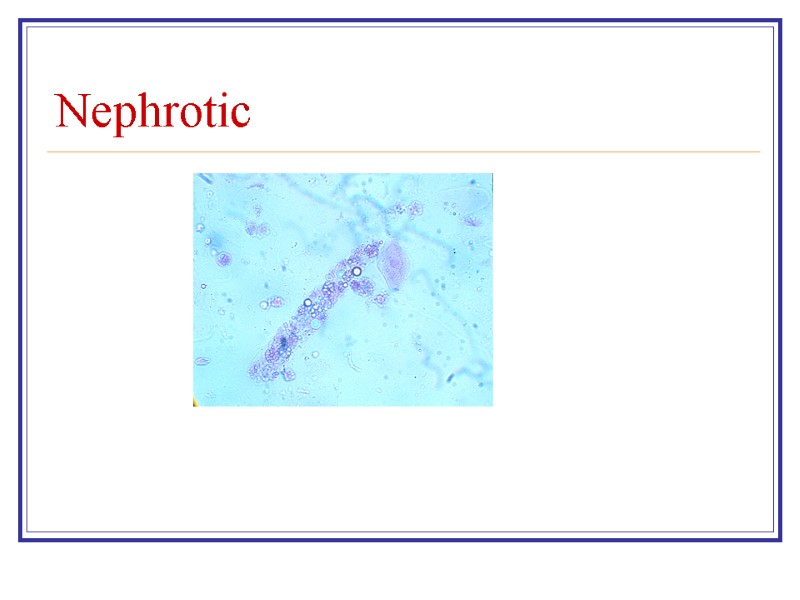
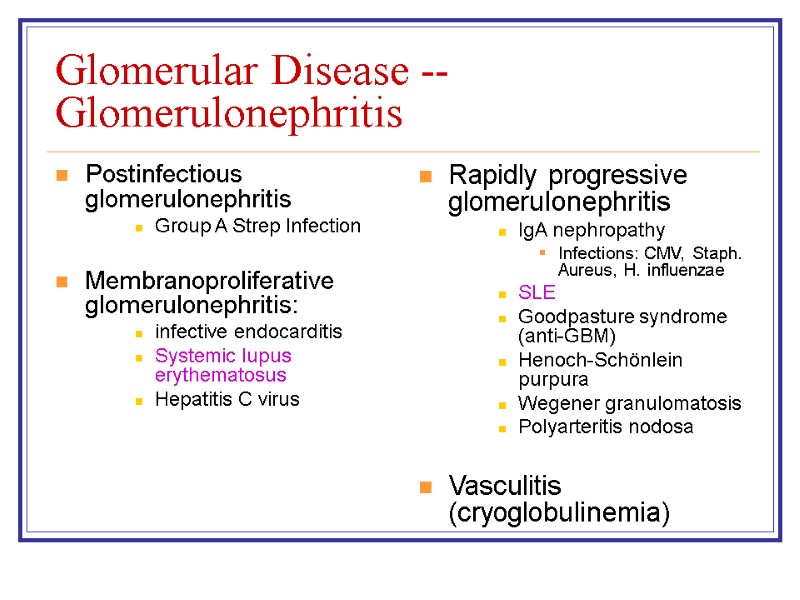
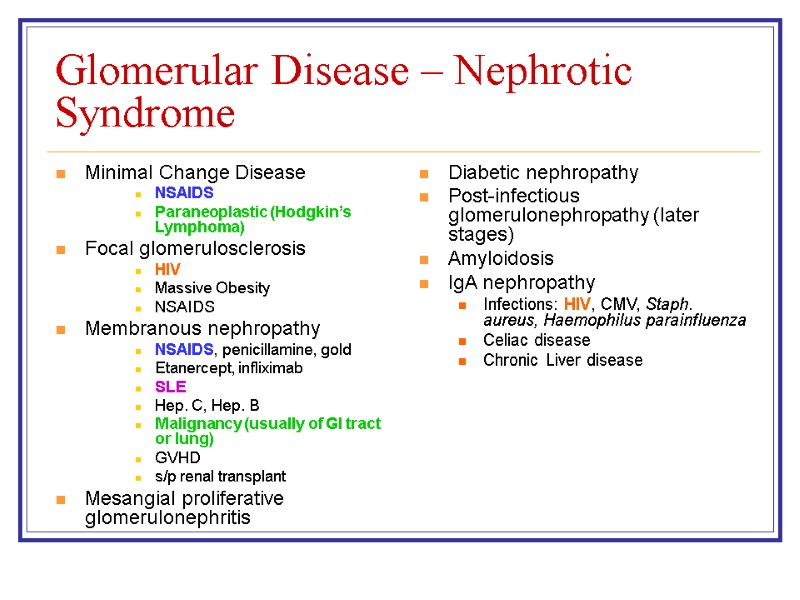
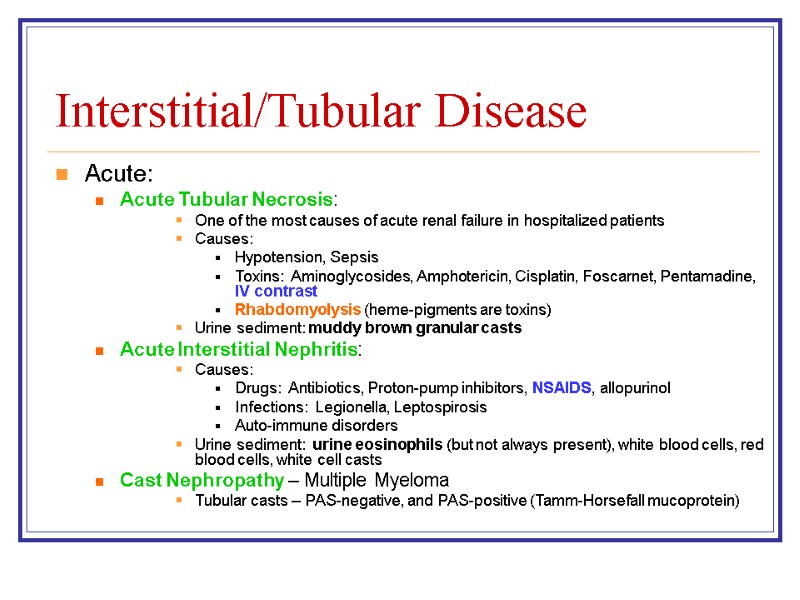
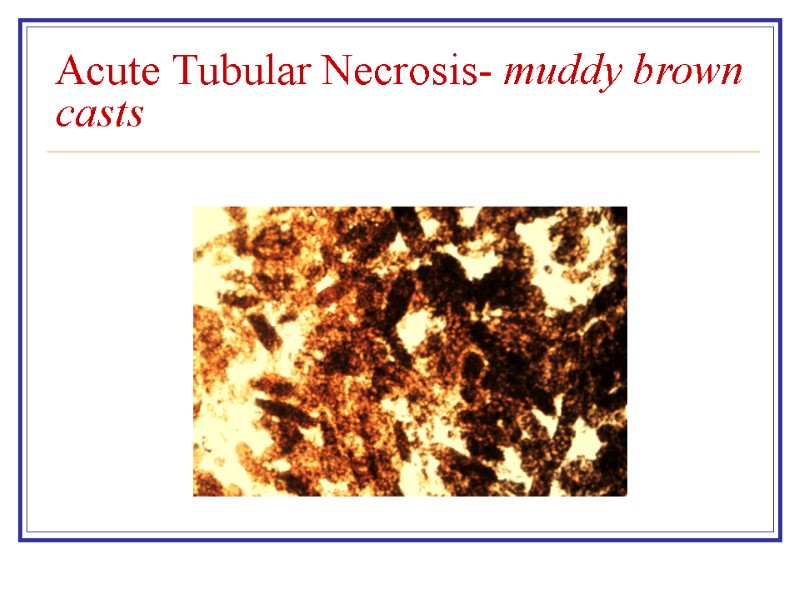
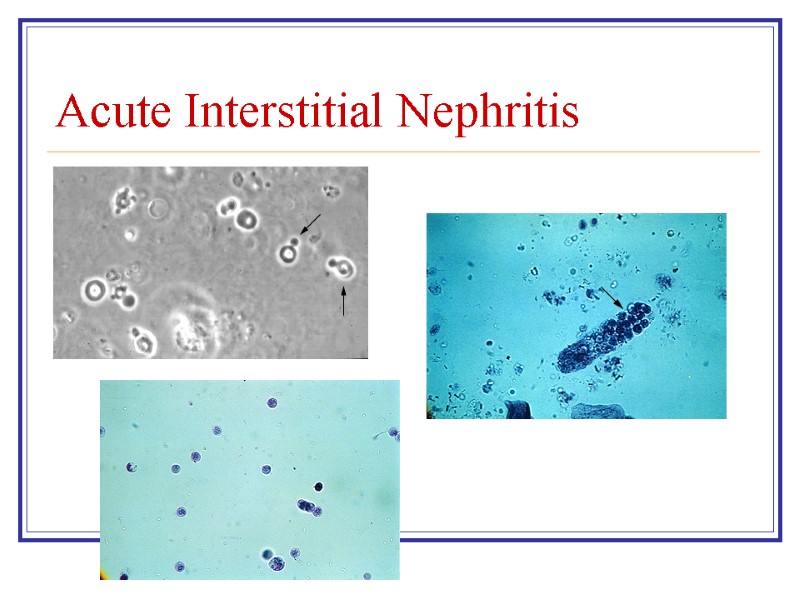

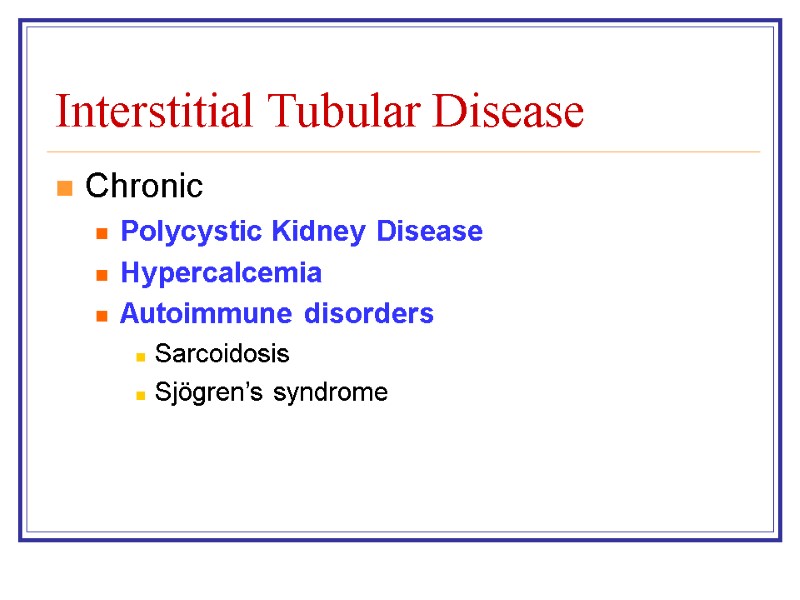
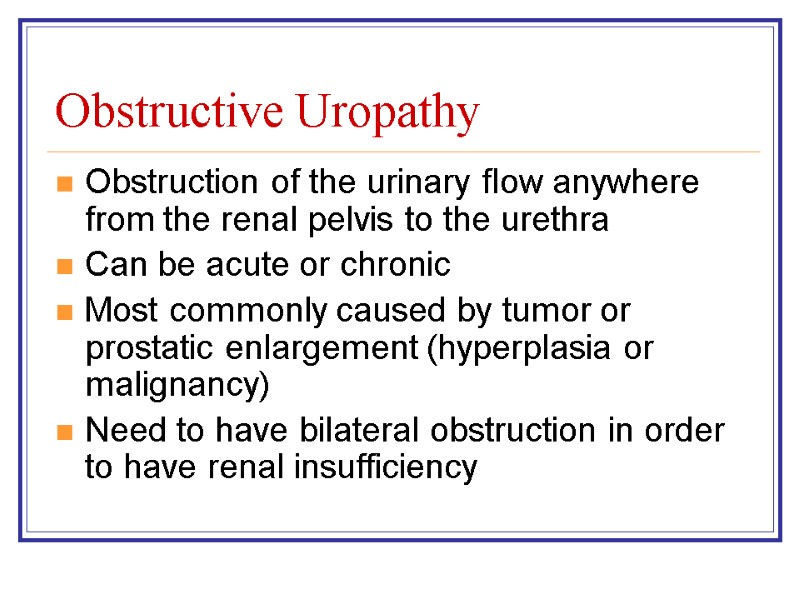
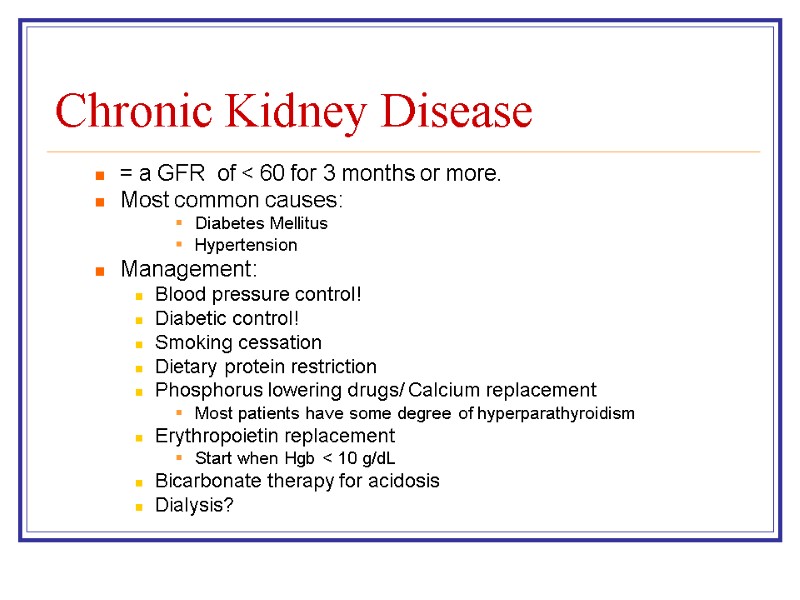
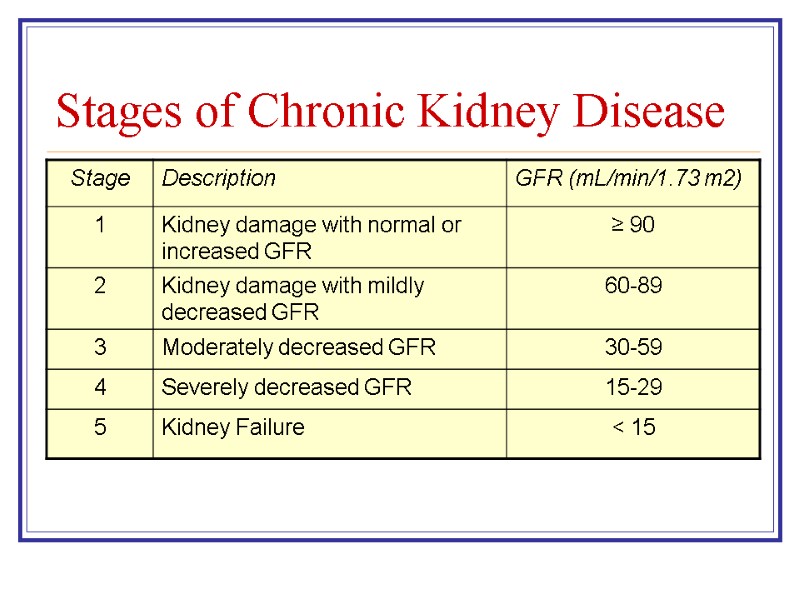
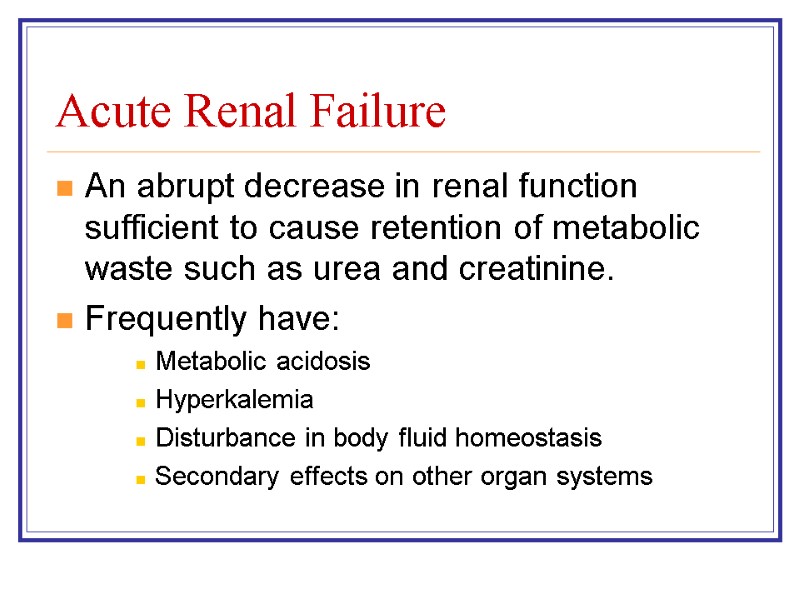
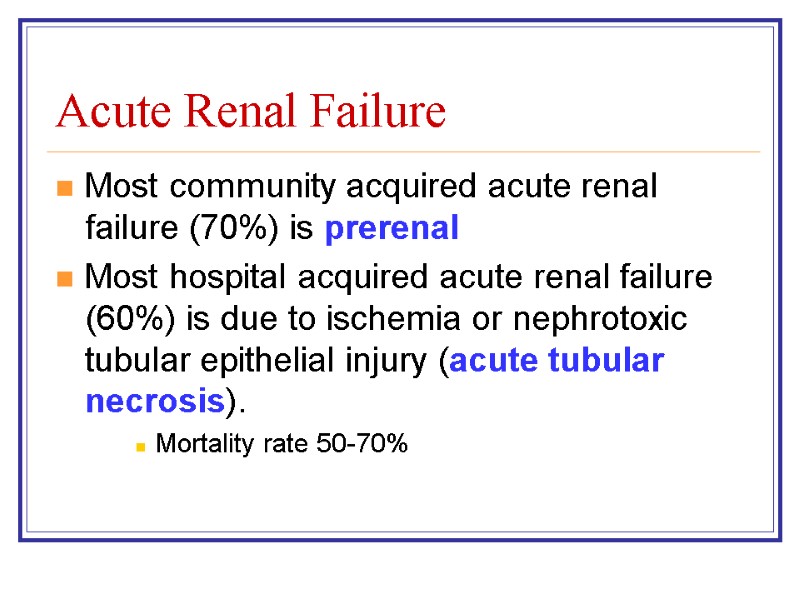
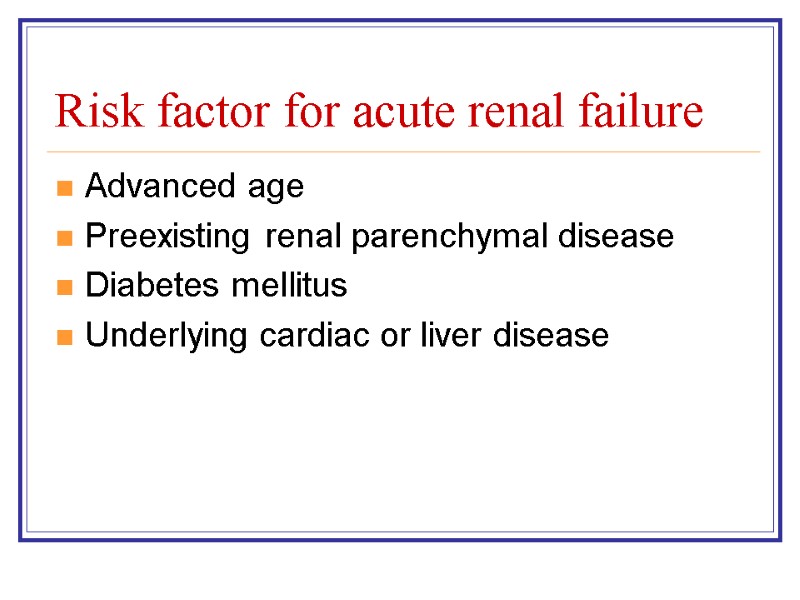
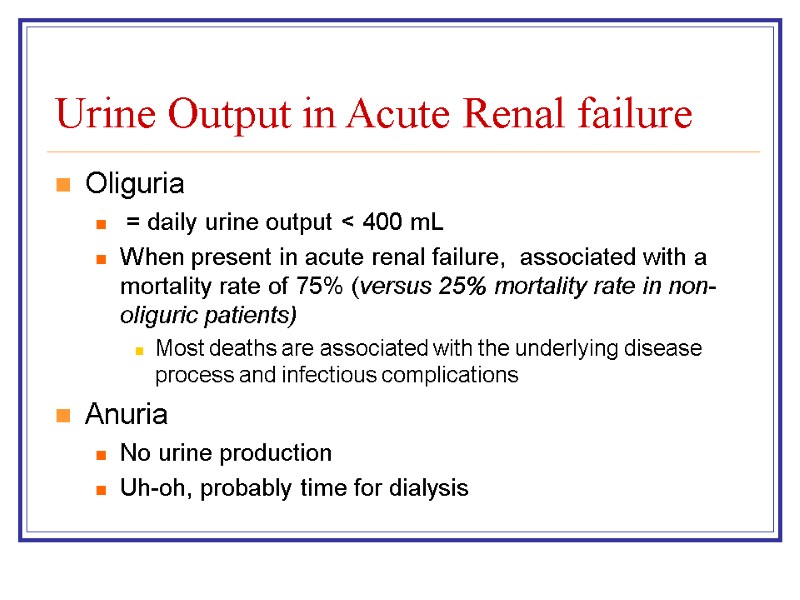
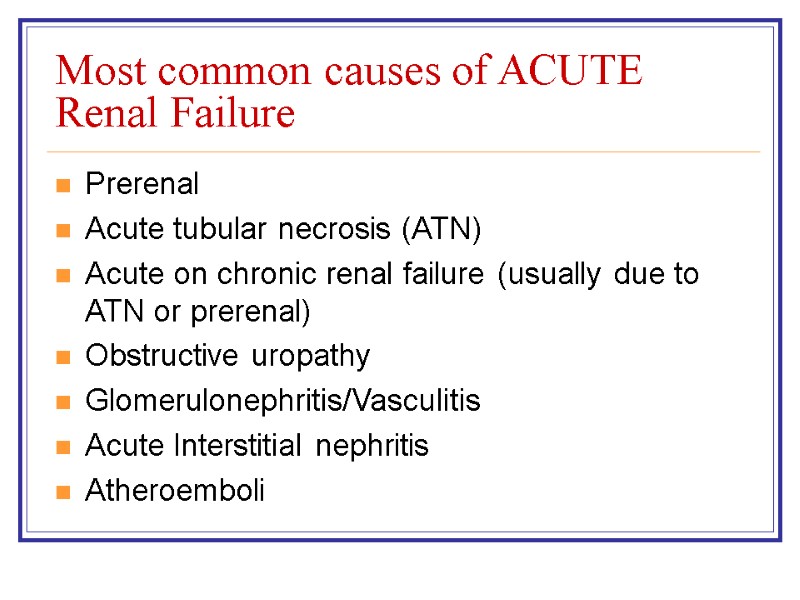
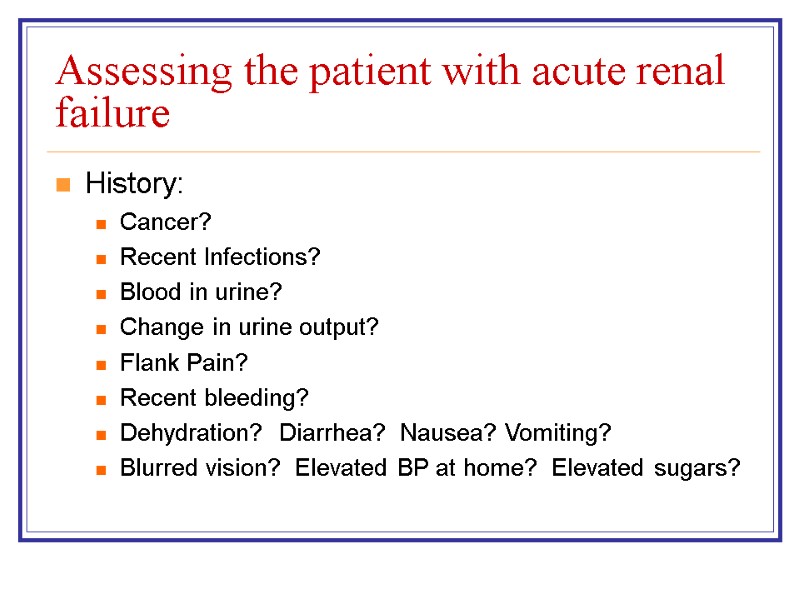
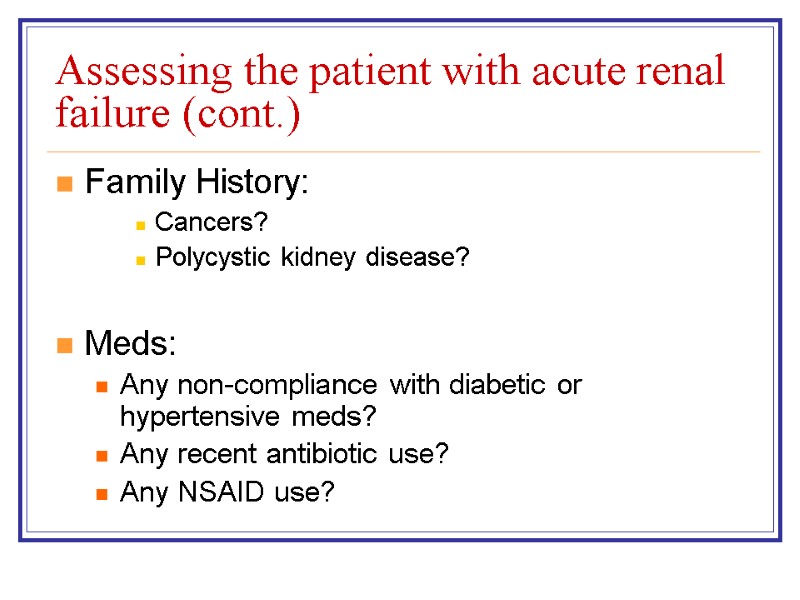
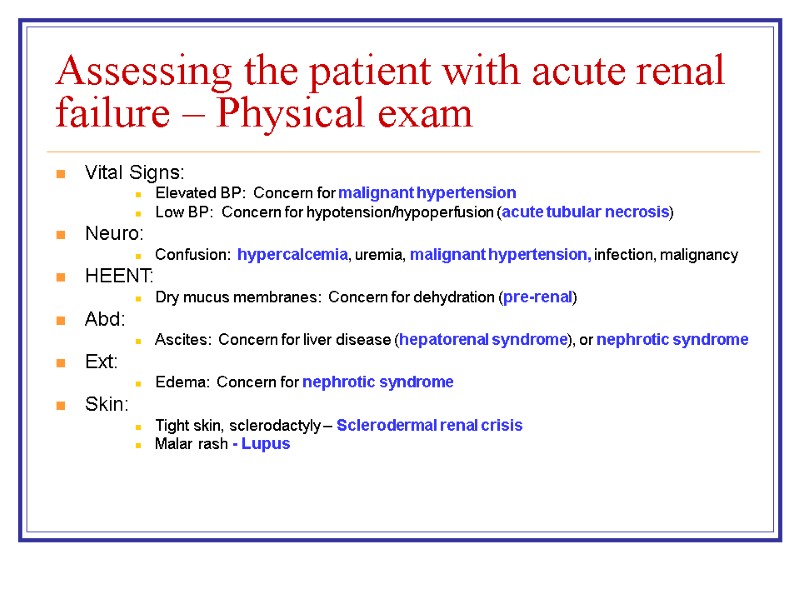

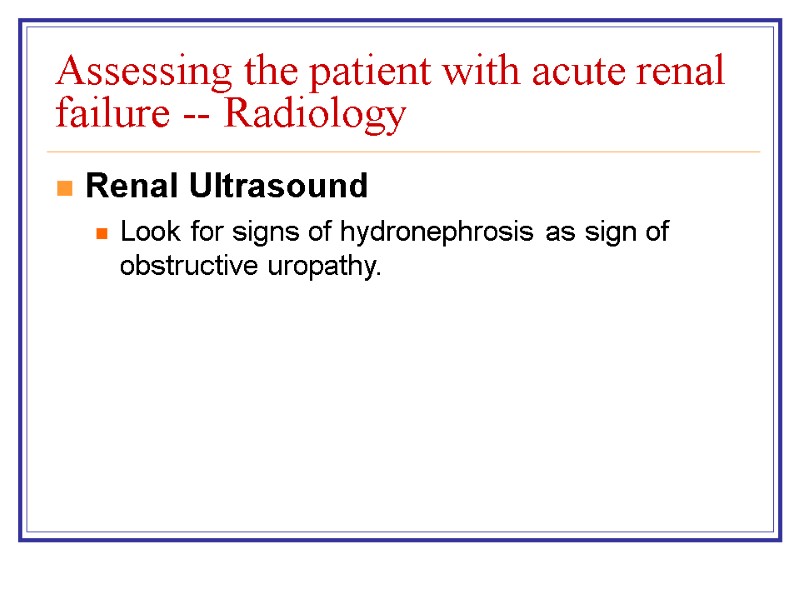
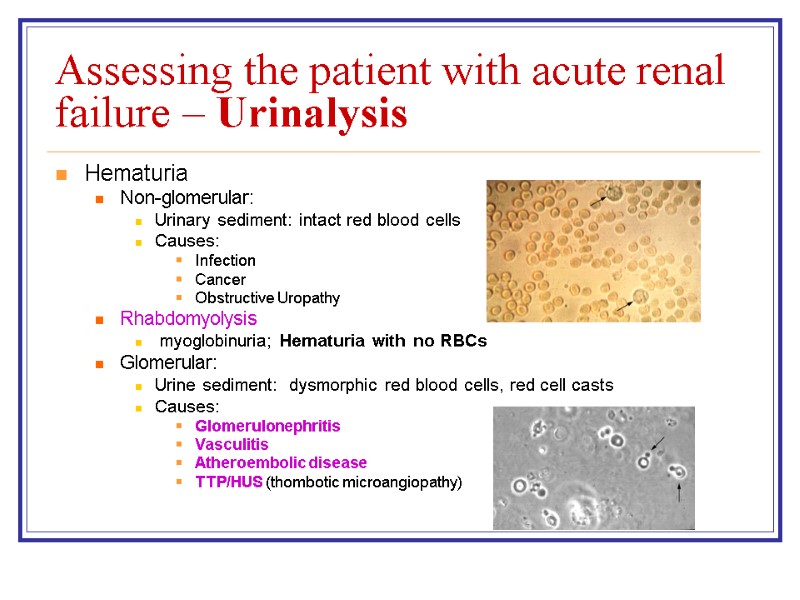
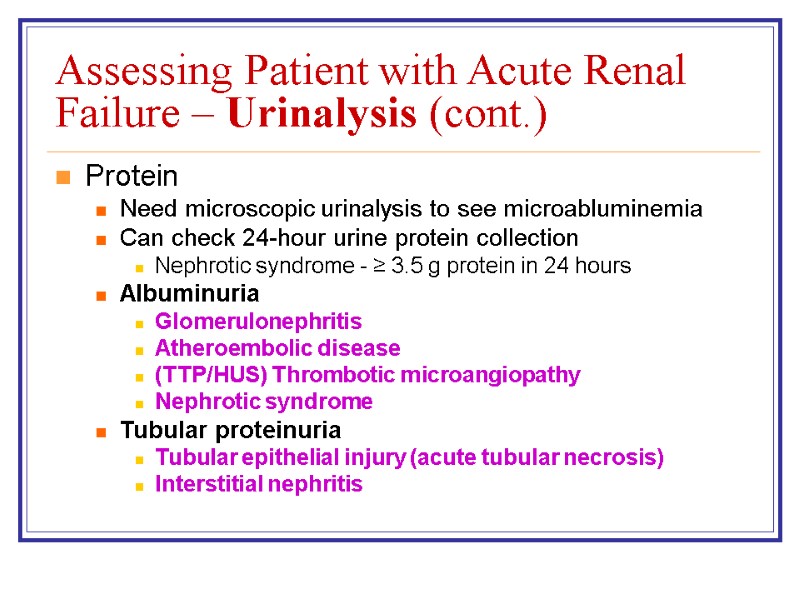


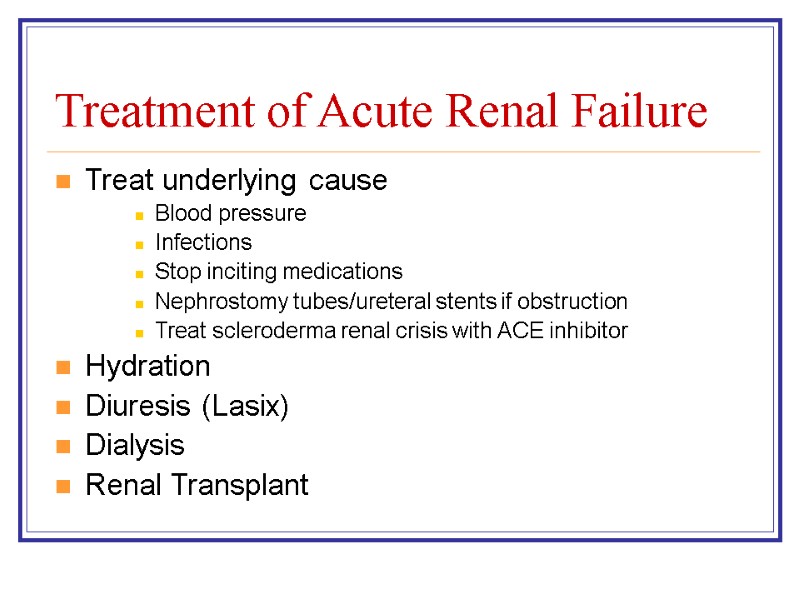
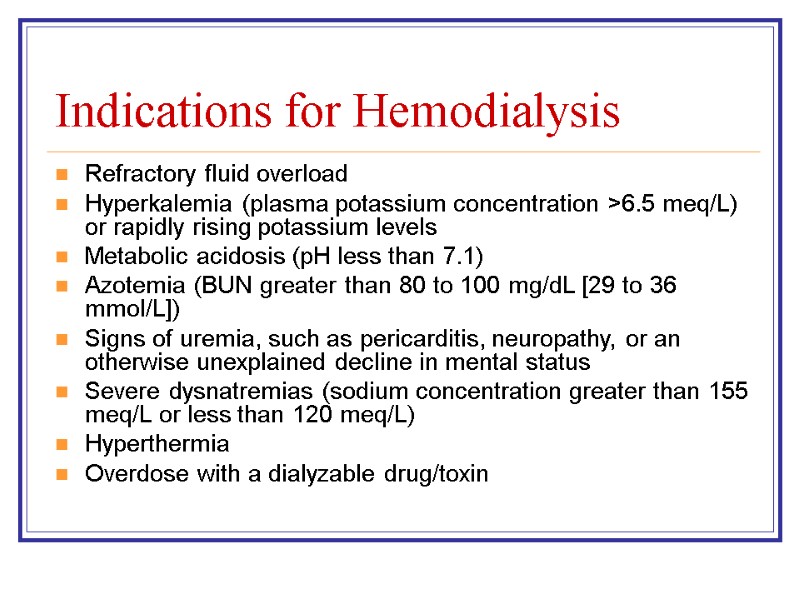
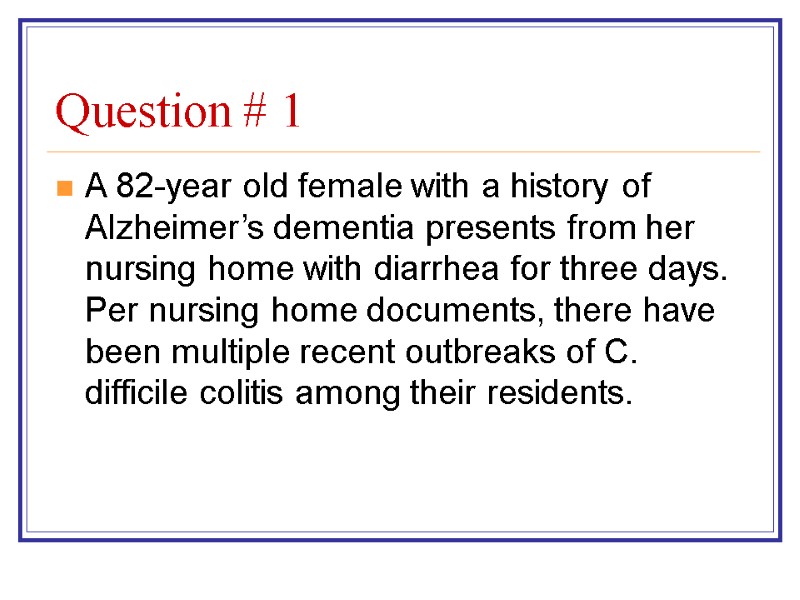

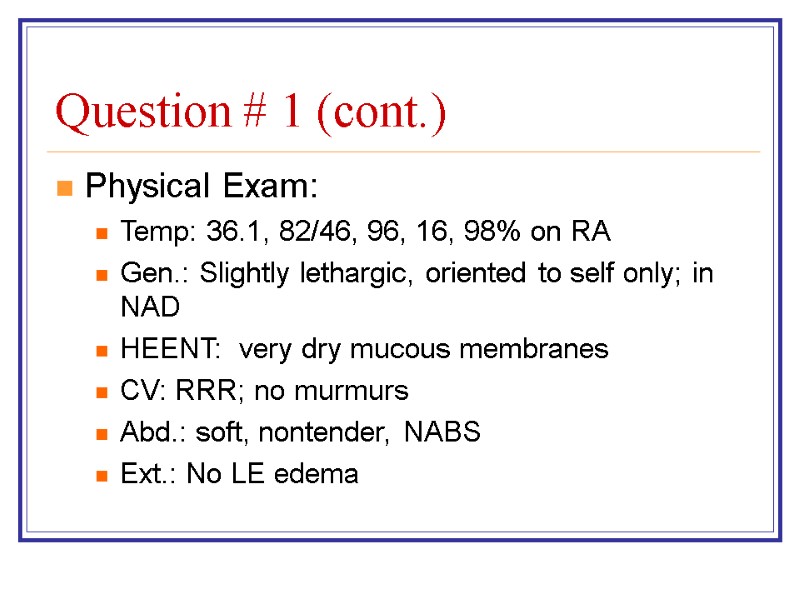
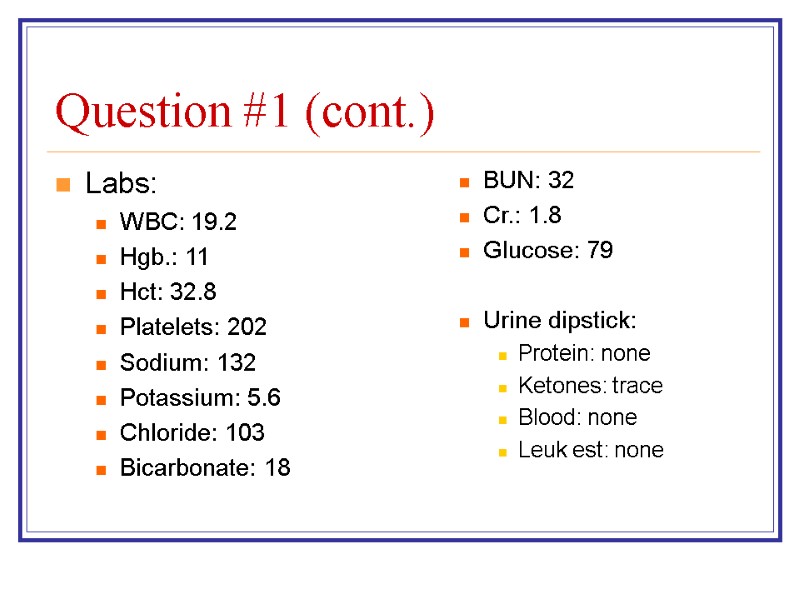
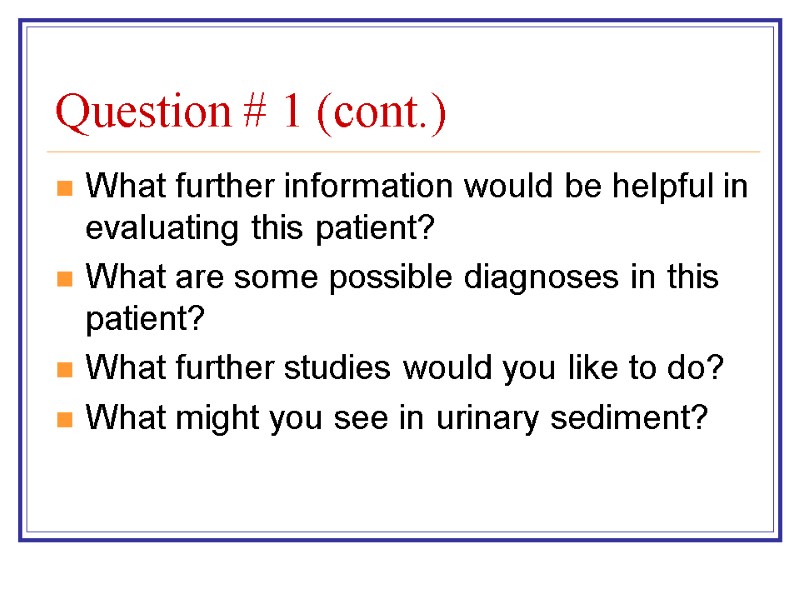
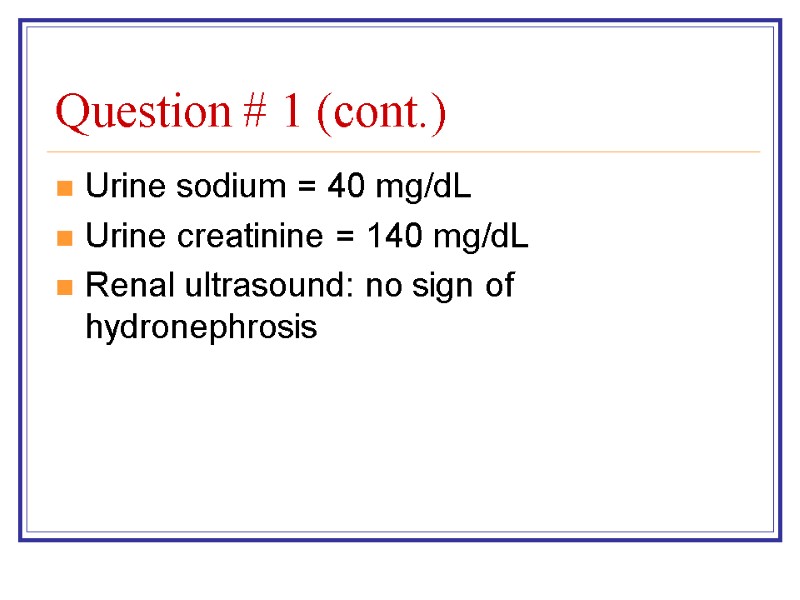
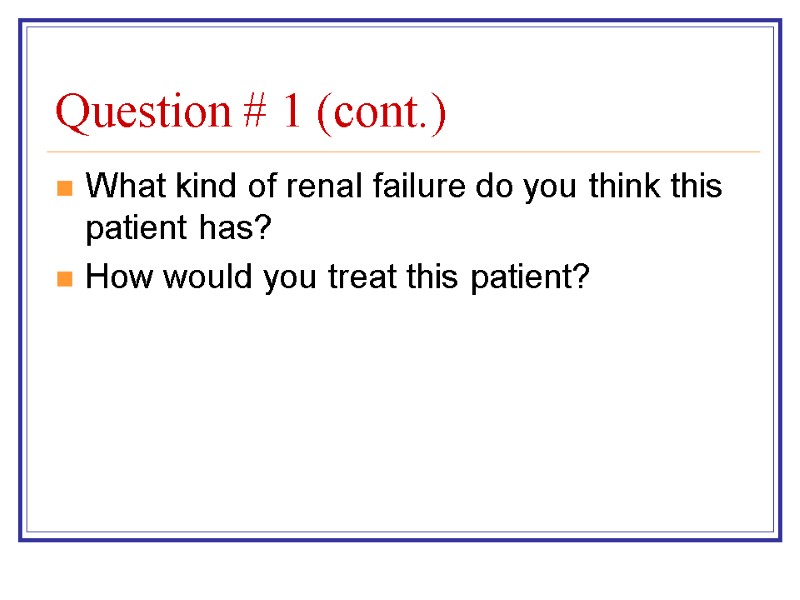
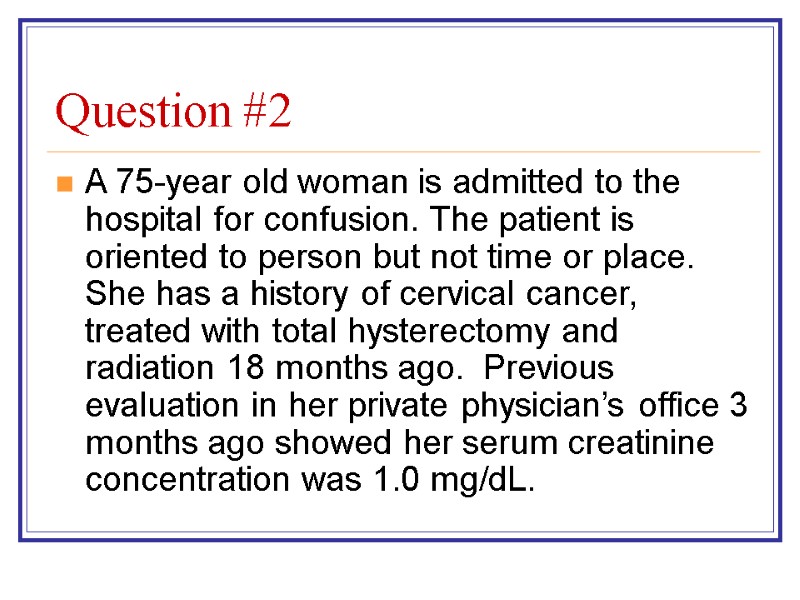
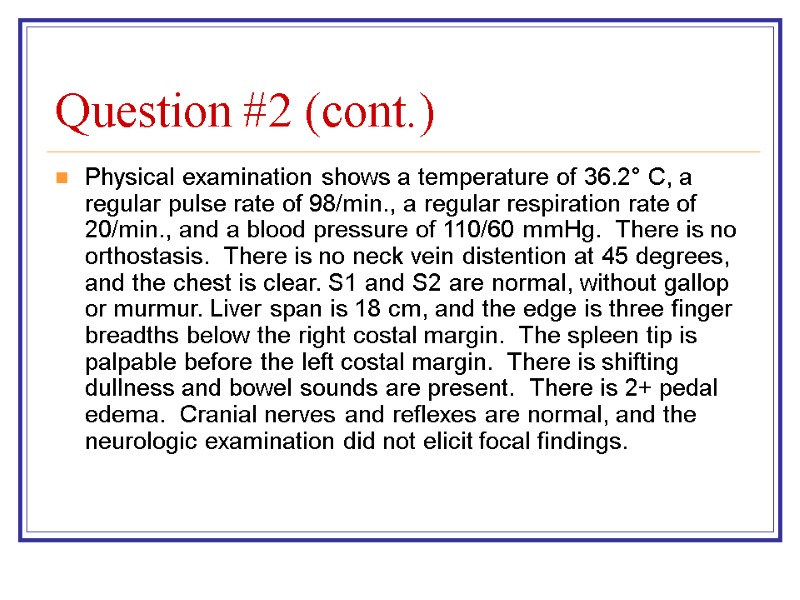
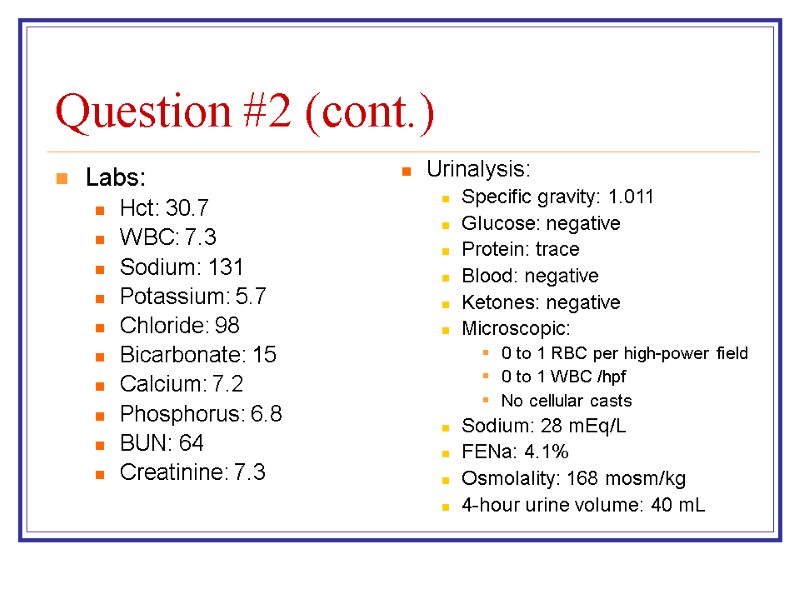
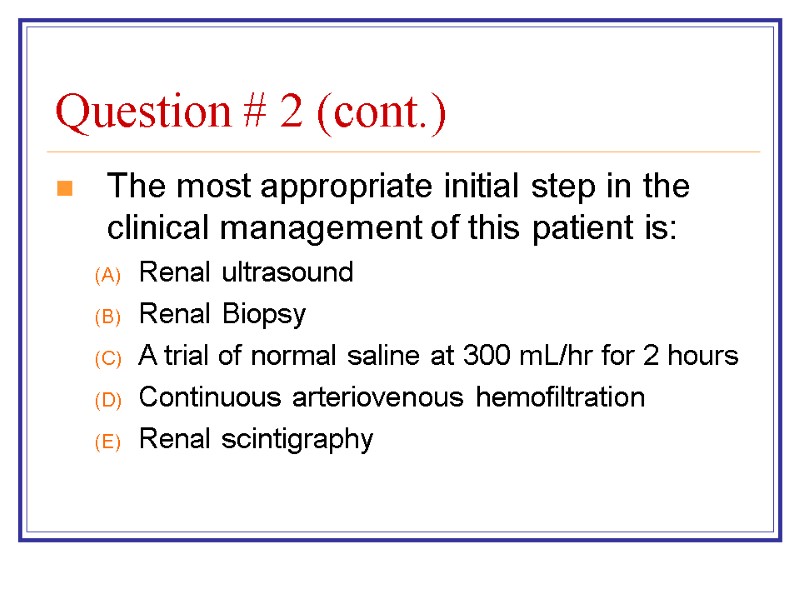
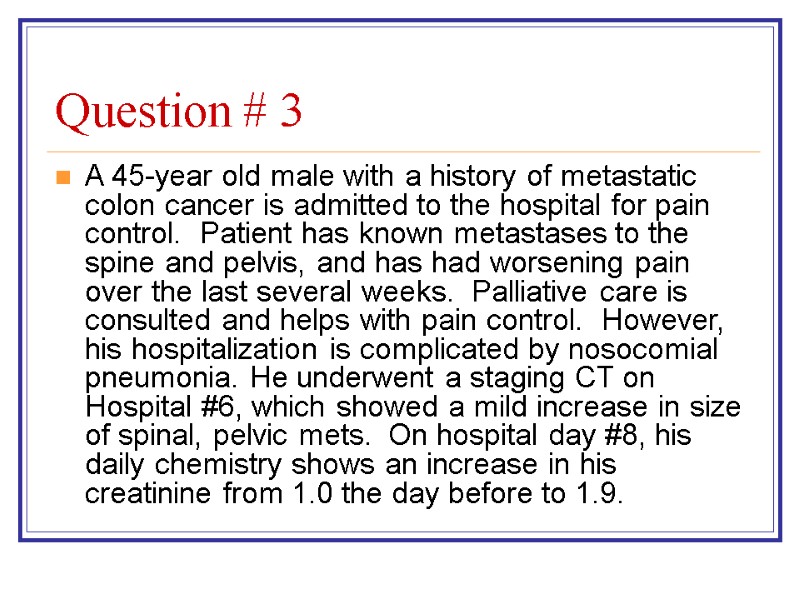
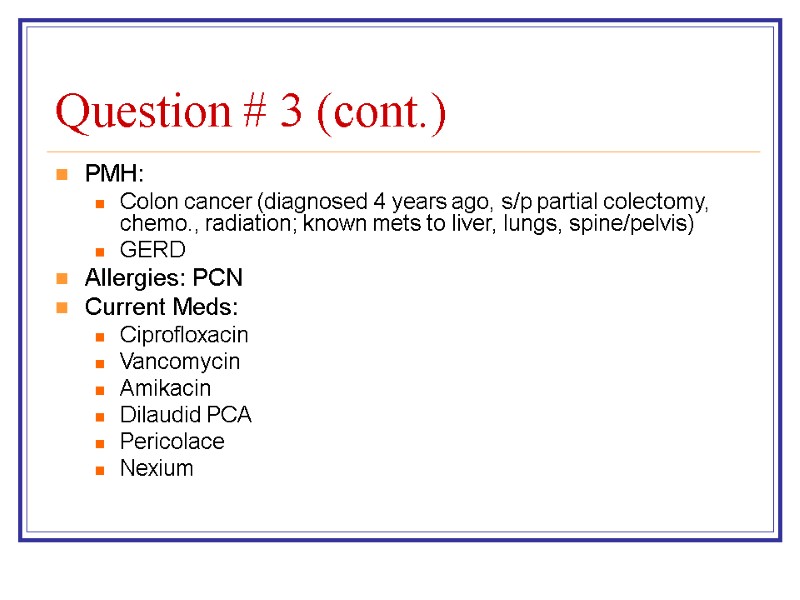
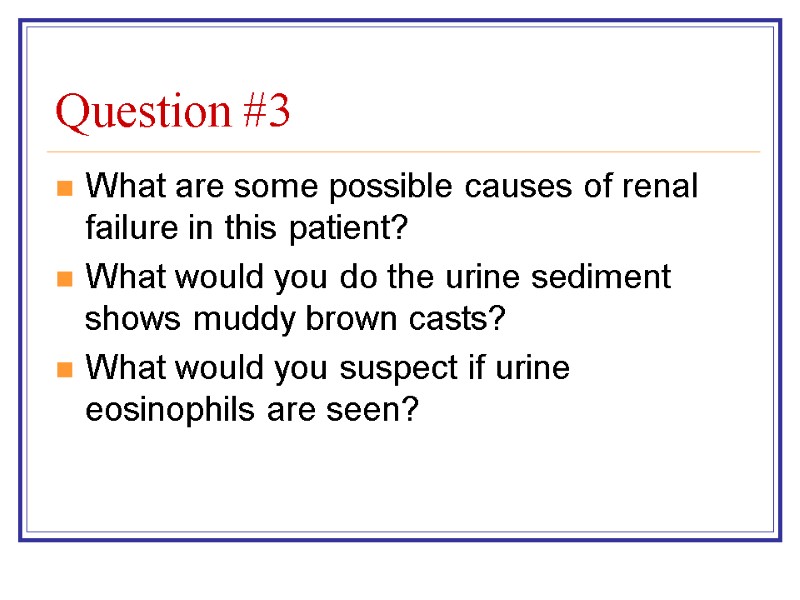
530-shelly_renal_failure.ppt
- Количество слайдов: 50
 Renal Failure Michele Ritter, M.D. Argy Resident – February, 2007
Renal Failure Michele Ritter, M.D. Argy Resident – February, 2007
 Assessment of Renal Function Glomerular Filtration Rate (GFR) = the volume of water filtered from the plasma per unit of time. Gives a rough measure of the number of functioning nephrons Normal GFR: Men: 130 mL/min./1.73m2 Women: 120 mL/min./1.73m2 Cannot be measured directly, so we use creatinine and creatinine clearance to estimate.
Assessment of Renal Function Glomerular Filtration Rate (GFR) = the volume of water filtered from the plasma per unit of time. Gives a rough measure of the number of functioning nephrons Normal GFR: Men: 130 mL/min./1.73m2 Women: 120 mL/min./1.73m2 Cannot be measured directly, so we use creatinine and creatinine clearance to estimate.
 Assessment of Renal Function (cont.) Creatinine A naturally occurring amino acid, predominately found in skeletal muscle Freely filtered in the glomerulus, excreted by the kidney and readily measured in the plasma As plasma creatinine increases, the GFR exponentially decreases. Limitations to estimate GFR: Patients with decrease in muscle mass, liver disease, malnutrition, advanced age, may have low/normal creatinine despite underlying kidney disease 15-20% of creatinine in the bloodstream is not filtered in glomerulus, but secreted by renal tubules (giving overestimation of GFR) Medications may artificially elevate creatinine: Trimethroprim (Bactrim) Cimetidine
Assessment of Renal Function (cont.) Creatinine A naturally occurring amino acid, predominately found in skeletal muscle Freely filtered in the glomerulus, excreted by the kidney and readily measured in the plasma As plasma creatinine increases, the GFR exponentially decreases. Limitations to estimate GFR: Patients with decrease in muscle mass, liver disease, malnutrition, advanced age, may have low/normal creatinine despite underlying kidney disease 15-20% of creatinine in the bloodstream is not filtered in glomerulus, but secreted by renal tubules (giving overestimation of GFR) Medications may artificially elevate creatinine: Trimethroprim (Bactrim) Cimetidine
 Assessment of Renal Function (cont.) Creatinine Clearance Best way to estimate GFR GFR = (creatinine clearance) x (body surface area in m2/1.73) Ways to measure: 24-hour urine creatinine: Creatinine clearance = (Ucr x Uvol)/ plasma Cr Cockcroft-Gault Equation: (140 - age) x lean body weight [kg] CrCl (mL/min) = ——————————————— x 0.85 if Cr [mg/dL] x 72 female Limitations: Based on white men with non-diabetes kidney disease Modification of Diet in Renal Disease (MDRD) Equation: GFR (mL/min./1.73m2) = 186 X (SCr)-1.154 X (Age)-0.203 X (0.742 if female) X (1.210 if African-American )
Assessment of Renal Function (cont.) Creatinine Clearance Best way to estimate GFR GFR = (creatinine clearance) x (body surface area in m2/1.73) Ways to measure: 24-hour urine creatinine: Creatinine clearance = (Ucr x Uvol)/ plasma Cr Cockcroft-Gault Equation: (140 - age) x lean body weight [kg] CrCl (mL/min) = ——————————————— x 0.85 if Cr [mg/dL] x 72 female Limitations: Based on white men with non-diabetes kidney disease Modification of Diet in Renal Disease (MDRD) Equation: GFR (mL/min./1.73m2) = 186 X (SCr)-1.154 X (Age)-0.203 X (0.742 if female) X (1.210 if African-American )
 Major causes of Kidney Failure Prerenal Disease Vascular Disease Glomerular Disease Interstitial/Tubular Disease Obstructive Uropathy
Major causes of Kidney Failure Prerenal Disease Vascular Disease Glomerular Disease Interstitial/Tubular Disease Obstructive Uropathy
 Prerenal Disease Reduced renal perfusion due to volume depletion and/or decreased perfusion Caused by: Dehydration Volume loss (bleeding) Heart failure Shock Liver disease
Prerenal Disease Reduced renal perfusion due to volume depletion and/or decreased perfusion Caused by: Dehydration Volume loss (bleeding) Heart failure Shock Liver disease
 Vascular Disease Acute Vasculitis – Wegener’s granulomatosis Thromboembolic disease TTP/HUS Malignant hypertension Scleroderma renal crisis Chronic Benign hypertensive nephrosclerosis Intimal thickening and luminal narrowing of the large and small renal arteries and the glomerular arterioles usually due to hypertension. Most common in African Americans Treatment: Hypertension control Bilateral renal artery stenosis should be suspected in patients with acute, severe, or refractory hypertension who also have otherwise unexplained renal insufficiency Treatment: Medical therapy, surgery, stents.
Vascular Disease Acute Vasculitis – Wegener’s granulomatosis Thromboembolic disease TTP/HUS Malignant hypertension Scleroderma renal crisis Chronic Benign hypertensive nephrosclerosis Intimal thickening and luminal narrowing of the large and small renal arteries and the glomerular arterioles usually due to hypertension. Most common in African Americans Treatment: Hypertension control Bilateral renal artery stenosis should be suspected in patients with acute, severe, or refractory hypertension who also have otherwise unexplained renal insufficiency Treatment: Medical therapy, surgery, stents.
 Glomerular Disease Nephritis Inflammation seen on histologic exam Active sediment: Red cells, white cells, granular casts, red cell casts Variable degree of proteinuria (< 3g/day) Nephrotic No inflammation Bland sediment: No cells, fatty casts Nephrotic range proteinuria (>3.5 g/day) Nephrotic syndrome = proteinuria + hyperlipidemia + edema
Glomerular Disease Nephritis Inflammation seen on histologic exam Active sediment: Red cells, white cells, granular casts, red cell casts Variable degree of proteinuria (< 3g/day) Nephrotic No inflammation Bland sediment: No cells, fatty casts Nephrotic range proteinuria (>3.5 g/day) Nephrotic syndrome = proteinuria + hyperlipidemia + edema
 Glomerulonephritis
Glomerulonephritis
 Nephrotic
Nephrotic
 Glomerular Disease -- Glomerulonephritis Postinfectious glomerulonephritis Group A Strep Infection Membranoproliferative glomerulonephritis: infective endocarditis Systemic lupus erythematosus Hepatitis C virus Rapidly progressive glomerulonephritis IgA nephropathy Infections: CMV, Staph. Aureus, H. influenzae SLE Goodpasture syndrome (anti-GBM) Henoch-Schönlein purpura Wegener granulomatosis Polyarteritis nodosa Vasculitis (cryoglobulinemia)
Glomerular Disease -- Glomerulonephritis Postinfectious glomerulonephritis Group A Strep Infection Membranoproliferative glomerulonephritis: infective endocarditis Systemic lupus erythematosus Hepatitis C virus Rapidly progressive glomerulonephritis IgA nephropathy Infections: CMV, Staph. Aureus, H. influenzae SLE Goodpasture syndrome (anti-GBM) Henoch-Schönlein purpura Wegener granulomatosis Polyarteritis nodosa Vasculitis (cryoglobulinemia)
 Glomerular Disease – Nephrotic Syndrome Minimal Change Disease NSAIDS Paraneoplastic (Hodgkin’s Lymphoma) Focal glomerulosclerosis HIV Massive Obesity NSAIDS Membranous nephropathy NSAIDS, penicillamine, gold Etanercept, infliximab SLE Hep. C, Hep. B Malignancy (usually of GI tract or lung) GVHD s/p renal transplant Mesangial proliferative glomerulonephritis Diabetic nephropathy Post-infectious glomerulonephropathy (later stages) Amyloidosis IgA nephropathy Infections: HIV, CMV, Staph. aureus, Haemophilus parainfluenza Celiac disease Chronic Liver disease
Glomerular Disease – Nephrotic Syndrome Minimal Change Disease NSAIDS Paraneoplastic (Hodgkin’s Lymphoma) Focal glomerulosclerosis HIV Massive Obesity NSAIDS Membranous nephropathy NSAIDS, penicillamine, gold Etanercept, infliximab SLE Hep. C, Hep. B Malignancy (usually of GI tract or lung) GVHD s/p renal transplant Mesangial proliferative glomerulonephritis Diabetic nephropathy Post-infectious glomerulonephropathy (later stages) Amyloidosis IgA nephropathy Infections: HIV, CMV, Staph. aureus, Haemophilus parainfluenza Celiac disease Chronic Liver disease
 Interstitial/Tubular Disease Acute: Acute Tubular Necrosis: One of the most causes of acute renal failure in hospitalized patients Causes: Hypotension, Sepsis Toxins: Aminoglycosides, Amphotericin, Cisplatin, Foscarnet, Pentamadine, IV contrast Rhabdomyolysis (heme-pigments are toxins) Urine sediment: muddy brown granular casts Acute Interstitial Nephritis: Causes: Drugs: Antibiotics, Proton-pump inhibitors, NSAIDS, allopurinol Infections: Legionella, Leptospirosis Auto-immune disorders Urine sediment: urine eosinophils (but not always present), white blood cells, red blood cells, white cell casts Cast Nephropathy – Multiple Myeloma Tubular casts – PAS-negative, and PAS-positive (Tamm-Horsefall mucoprotein)
Interstitial/Tubular Disease Acute: Acute Tubular Necrosis: One of the most causes of acute renal failure in hospitalized patients Causes: Hypotension, Sepsis Toxins: Aminoglycosides, Amphotericin, Cisplatin, Foscarnet, Pentamadine, IV contrast Rhabdomyolysis (heme-pigments are toxins) Urine sediment: muddy brown granular casts Acute Interstitial Nephritis: Causes: Drugs: Antibiotics, Proton-pump inhibitors, NSAIDS, allopurinol Infections: Legionella, Leptospirosis Auto-immune disorders Urine sediment: urine eosinophils (but not always present), white blood cells, red blood cells, white cell casts Cast Nephropathy – Multiple Myeloma Tubular casts – PAS-negative, and PAS-positive (Tamm-Horsefall mucoprotein)
 Acute Tubular Necrosis- muddy brown casts
Acute Tubular Necrosis- muddy brown casts
 Acute Interstitial Nephritis
Acute Interstitial Nephritis
 Cast nephropathy – Multiple myeloma tubular casts
Cast nephropathy – Multiple myeloma tubular casts
 Interstitial Tubular Disease Chronic Polycystic Kidney Disease Hypercalcemia Autoimmune disorders Sarcoidosis Sjögren’s syndrome
Interstitial Tubular Disease Chronic Polycystic Kidney Disease Hypercalcemia Autoimmune disorders Sarcoidosis Sjögren’s syndrome
 Obstructive Uropathy Obstruction of the urinary flow anywhere from the renal pelvis to the urethra Can be acute or chronic Most commonly caused by tumor or prostatic enlargement (hyperplasia or malignancy) Need to have bilateral obstruction in order to have renal insufficiency
Obstructive Uropathy Obstruction of the urinary flow anywhere from the renal pelvis to the urethra Can be acute or chronic Most commonly caused by tumor or prostatic enlargement (hyperplasia or malignancy) Need to have bilateral obstruction in order to have renal insufficiency
 Chronic Kidney Disease = a GFR of < 60 for 3 months or more. Most common causes: Diabetes Mellitus Hypertension Management: Blood pressure control! Diabetic control! Smoking cessation Dietary protein restriction Phosphorus lowering drugs/ Calcium replacement Most patients have some degree of hyperparathyroidism Erythropoietin replacement Start when Hgb < 10 g/dL Bicarbonate therapy for acidosis Dialysis?
Chronic Kidney Disease = a GFR of < 60 for 3 months or more. Most common causes: Diabetes Mellitus Hypertension Management: Blood pressure control! Diabetic control! Smoking cessation Dietary protein restriction Phosphorus lowering drugs/ Calcium replacement Most patients have some degree of hyperparathyroidism Erythropoietin replacement Start when Hgb < 10 g/dL Bicarbonate therapy for acidosis Dialysis?
 Stages of Chronic Kidney Disease
Stages of Chronic Kidney Disease
 Acute Renal Failure An abrupt decrease in renal function sufficient to cause retention of metabolic waste such as urea and creatinine. Frequently have: Metabolic acidosis Hyperkalemia Disturbance in body fluid homeostasis Secondary effects on other organ systems
Acute Renal Failure An abrupt decrease in renal function sufficient to cause retention of metabolic waste such as urea and creatinine. Frequently have: Metabolic acidosis Hyperkalemia Disturbance in body fluid homeostasis Secondary effects on other organ systems
 Acute Renal Failure Most community acquired acute renal failure (70%) is prerenal Most hospital acquired acute renal failure (60%) is due to ischemia or nephrotoxic tubular epithelial injury (acute tubular necrosis). Mortality rate 50-70%
Acute Renal Failure Most community acquired acute renal failure (70%) is prerenal Most hospital acquired acute renal failure (60%) is due to ischemia or nephrotoxic tubular epithelial injury (acute tubular necrosis). Mortality rate 50-70%
 Advanced age Preexisting renal parenchymal disease Diabetes mellitus Underlying cardiac or liver disease Risk factor for acute renal failure
Advanced age Preexisting renal parenchymal disease Diabetes mellitus Underlying cardiac or liver disease Risk factor for acute renal failure
 Urine Output in Acute Renal failure Oliguria = daily urine output < 400 mL When present in acute renal failure, associated with a mortality rate of 75% (versus 25% mortality rate in non-oliguric patients) Most deaths are associated with the underlying disease process and infectious complications Anuria No urine production Uh-oh, probably time for dialysis
Urine Output in Acute Renal failure Oliguria = daily urine output < 400 mL When present in acute renal failure, associated with a mortality rate of 75% (versus 25% mortality rate in non-oliguric patients) Most deaths are associated with the underlying disease process and infectious complications Anuria No urine production Uh-oh, probably time for dialysis
 Most common causes of ACUTE Renal Failure Prerenal Acute tubular necrosis (ATN) Acute on chronic renal failure (usually due to ATN or prerenal) Obstructive uropathy Glomerulonephritis/Vasculitis Acute Interstitial nephritis Atheroemboli
Most common causes of ACUTE Renal Failure Prerenal Acute tubular necrosis (ATN) Acute on chronic renal failure (usually due to ATN or prerenal) Obstructive uropathy Glomerulonephritis/Vasculitis Acute Interstitial nephritis Atheroemboli
 Assessing the patient with acute renal failure History: Cancer? Recent Infections? Blood in urine? Change in urine output? Flank Pain? Recent bleeding? Dehydration? Diarrhea? Nausea? Vomiting? Blurred vision? Elevated BP at home? Elevated sugars?
Assessing the patient with acute renal failure History: Cancer? Recent Infections? Blood in urine? Change in urine output? Flank Pain? Recent bleeding? Dehydration? Diarrhea? Nausea? Vomiting? Blurred vision? Elevated BP at home? Elevated sugars?
 Assessing the patient with acute renal failure (cont.) Family History: Cancers? Polycystic kidney disease? Meds: Any non-compliance with diabetic or hypertensive meds? Any recent antibiotic use? Any NSAID use?
Assessing the patient with acute renal failure (cont.) Family History: Cancers? Polycystic kidney disease? Meds: Any non-compliance with diabetic or hypertensive meds? Any recent antibiotic use? Any NSAID use?
 Assessing the patient with acute renal failure – Physical exam Vital Signs: Elevated BP: Concern for malignant hypertension Low BP: Concern for hypotension/hypoperfusion (acute tubular necrosis) Neuro: Confusion: hypercalcemia, uremia, malignant hypertension, infection, malignancy HEENT: Dry mucus membranes: Concern for dehydration (pre-renal) Abd: Ascites: Concern for liver disease (hepatorenal syndrome), or nephrotic syndrome Ext: Edema: Concern for nephrotic syndrome Skin: Tight skin, sclerodactyly – Sclerodermal renal crisis Malar rash - Lupus
Assessing the patient with acute renal failure – Physical exam Vital Signs: Elevated BP: Concern for malignant hypertension Low BP: Concern for hypotension/hypoperfusion (acute tubular necrosis) Neuro: Confusion: hypercalcemia, uremia, malignant hypertension, infection, malignancy HEENT: Dry mucus membranes: Concern for dehydration (pre-renal) Abd: Ascites: Concern for liver disease (hepatorenal syndrome), or nephrotic syndrome Ext: Edema: Concern for nephrotic syndrome Skin: Tight skin, sclerodactyly – Sclerodermal renal crisis Malar rash - Lupus
 Assessing the patient with acute renal failure – Laboratory analysis Fractional excretion of sodium: (UrineNa+ x PlasmaCreatinine) FENa= ______________________ x 100 (PlasmaNa+ x UrineCreatinine) FENa < 1% → Prerenal FENa > 2% → Epithelial tubular injury (acute tubular necrosis), obstructive uropathy If patient receiving diuretics, can check FE of urea.
Assessing the patient with acute renal failure – Laboratory analysis Fractional excretion of sodium: (UrineNa+ x PlasmaCreatinine) FENa= ______________________ x 100 (PlasmaNa+ x UrineCreatinine) FENa < 1% → Prerenal FENa > 2% → Epithelial tubular injury (acute tubular necrosis), obstructive uropathy If patient receiving diuretics, can check FE of urea.
 Assessing the patient with acute renal failure -- Radiology Renal Ultrasound Look for signs of hydronephrosis as sign of obstructive uropathy.
Assessing the patient with acute renal failure -- Radiology Renal Ultrasound Look for signs of hydronephrosis as sign of obstructive uropathy.
 Assessing the patient with acute renal failure – Urinalysis Hematuria Non-glomerular: Urinary sediment: intact red blood cells Causes: Infection Cancer Obstructive Uropathy Rhabdomyolysis myoglobinuria; Hematuria with no RBCs Glomerular: Urine sediment: dysmorphic red blood cells, red cell casts Causes: Glomerulonephritis Vasculitis Atheroembolic disease TTP/HUS (thombotic microangiopathy)
Assessing the patient with acute renal failure – Urinalysis Hematuria Non-glomerular: Urinary sediment: intact red blood cells Causes: Infection Cancer Obstructive Uropathy Rhabdomyolysis myoglobinuria; Hematuria with no RBCs Glomerular: Urine sediment: dysmorphic red blood cells, red cell casts Causes: Glomerulonephritis Vasculitis Atheroembolic disease TTP/HUS (thombotic microangiopathy)
 Assessing Patient with Acute Renal Failure – Urinalysis (cont.) Protein Need microscopic urinalysis to see microabluminemia Can check 24-hour urine protein collection Nephrotic syndrome - ≥ 3.5 g protein in 24 hours Albuminuria Glomerulonephritis Atheroembolic disease (TTP/HUS) Thrombotic microangiopathy Nephrotic syndrome Tubular proteinuria Tubular epithelial injury (acute tubular necrosis) Interstitial nephritis
Assessing Patient with Acute Renal Failure – Urinalysis (cont.) Protein Need microscopic urinalysis to see microabluminemia Can check 24-hour urine protein collection Nephrotic syndrome - ≥ 3.5 g protein in 24 hours Albuminuria Glomerulonephritis Atheroembolic disease (TTP/HUS) Thrombotic microangiopathy Nephrotic syndrome Tubular proteinuria Tubular epithelial injury (acute tubular necrosis) Interstitial nephritis
 Assessing patient with acute renal failure – Urinary Casts
Assessing patient with acute renal failure – Urinary Casts
 Assessing patient with acute renal failure – Renal Biopsy If unable to discover cause of renal disease, renal biopsy may be warranted. Renal biopsy frequently performed in patient’s with history of renal transplant with worsening renal function.
Assessing patient with acute renal failure – Renal Biopsy If unable to discover cause of renal disease, renal biopsy may be warranted. Renal biopsy frequently performed in patient’s with history of renal transplant with worsening renal function.
 Treatment of Acute Renal Failure Treat underlying cause Blood pressure Infections Stop inciting medications Nephrostomy tubes/ureteral stents if obstruction Treat scleroderma renal crisis with ACE inhibitor Hydration Diuresis (Lasix) Dialysis Renal Transplant
Treatment of Acute Renal Failure Treat underlying cause Blood pressure Infections Stop inciting medications Nephrostomy tubes/ureteral stents if obstruction Treat scleroderma renal crisis with ACE inhibitor Hydration Diuresis (Lasix) Dialysis Renal Transplant
 Indications for Hemodialysis Refractory fluid overload Hyperkalemia (plasma potassium concentration >6.5 meq/L) or rapidly rising potassium levels Metabolic acidosis (pH less than 7.1) Azotemia (BUN greater than 80 to 100 mg/dL [29 to 36 mmol/L]) Signs of uremia, such as pericarditis, neuropathy, or an otherwise unexplained decline in mental status Severe dysnatremias (sodium concentration greater than 155 meq/L or less than 120 meq/L) Hyperthermia Overdose with a dialyzable drug/toxin
Indications for Hemodialysis Refractory fluid overload Hyperkalemia (plasma potassium concentration >6.5 meq/L) or rapidly rising potassium levels Metabolic acidosis (pH less than 7.1) Azotemia (BUN greater than 80 to 100 mg/dL [29 to 36 mmol/L]) Signs of uremia, such as pericarditis, neuropathy, or an otherwise unexplained decline in mental status Severe dysnatremias (sodium concentration greater than 155 meq/L or less than 120 meq/L) Hyperthermia Overdose with a dialyzable drug/toxin
 Question # 1 A 82-year old female with a history of Alzheimer’s dementia presents from her nursing home with diarrhea for three days. Per nursing home documents, there have been multiple recent outbreaks of C. difficile colitis among their residents.
Question # 1 A 82-year old female with a history of Alzheimer’s dementia presents from her nursing home with diarrhea for three days. Per nursing home documents, there have been multiple recent outbreaks of C. difficile colitis among their residents.
 Question #1 PMH: Alzheimer’s Dementia Osteoarthritis Allergies: PCN Meds: Aricept Ibuprofen prn
Question #1 PMH: Alzheimer’s Dementia Osteoarthritis Allergies: PCN Meds: Aricept Ibuprofen prn
 Question # 1 (cont.) Physical Exam: Temp: 36.1, 82/46, 96, 16, 98% on RA Gen.: Slightly lethargic, oriented to self only; in NAD HEENT: very dry mucous membranes CV: RRR; no murmurs Abd.: soft, nontender, NABS Ext.: No LE edema
Question # 1 (cont.) Physical Exam: Temp: 36.1, 82/46, 96, 16, 98% on RA Gen.: Slightly lethargic, oriented to self only; in NAD HEENT: very dry mucous membranes CV: RRR; no murmurs Abd.: soft, nontender, NABS Ext.: No LE edema
 Question #1 (cont.) Labs: WBC: 19.2 Hgb.: 11 Hct: 32.8 Platelets: 202 Sodium: 132 Potassium: 5.6 Chloride: 103 Bicarbonate: 18 BUN: 32 Cr.: 1.8 Glucose: 79 Urine dipstick: Protein: none Ketones: trace Blood: none Leuk est: none
Question #1 (cont.) Labs: WBC: 19.2 Hgb.: 11 Hct: 32.8 Platelets: 202 Sodium: 132 Potassium: 5.6 Chloride: 103 Bicarbonate: 18 BUN: 32 Cr.: 1.8 Glucose: 79 Urine dipstick: Protein: none Ketones: trace Blood: none Leuk est: none
 Question # 1 (cont.) What further information would be helpful in evaluating this patient? What are some possible diagnoses in this patient? What further studies would you like to do? What might you see in urinary sediment?
Question # 1 (cont.) What further information would be helpful in evaluating this patient? What are some possible diagnoses in this patient? What further studies would you like to do? What might you see in urinary sediment?
 Question # 1 (cont.) Urine sodium = 40 mg/dL Urine creatinine = 140 mg/dL Renal ultrasound: no sign of hydronephrosis
Question # 1 (cont.) Urine sodium = 40 mg/dL Urine creatinine = 140 mg/dL Renal ultrasound: no sign of hydronephrosis
 Question # 1 (cont.) What kind of renal failure do you think this patient has? How would you treat this patient?
Question # 1 (cont.) What kind of renal failure do you think this patient has? How would you treat this patient?
 Question #2 A 75-year old woman is admitted to the hospital for confusion. The patient is oriented to person but not time or place. She has a history of cervical cancer, treated with total hysterectomy and radiation 18 months ago. Previous evaluation in her private physician’s office 3 months ago showed her serum creatinine concentration was 1.0 mg/dL.
Question #2 A 75-year old woman is admitted to the hospital for confusion. The patient is oriented to person but not time or place. She has a history of cervical cancer, treated with total hysterectomy and radiation 18 months ago. Previous evaluation in her private physician’s office 3 months ago showed her serum creatinine concentration was 1.0 mg/dL.
 Question #2 (cont.) Physical examination shows a temperature of 36.2° C, a regular pulse rate of 98/min., a regular respiration rate of 20/min., and a blood pressure of 110/60 mmHg. There is no orthostasis. There is no neck vein distention at 45 degrees, and the chest is clear. S1 and S2 are normal, without gallop or murmur. Liver span is 18 cm, and the edge is three finger breadths below the right costal margin. The spleen tip is palpable before the left costal margin. There is shifting dullness and bowel sounds are present. There is 2+ pedal edema. Cranial nerves and reflexes are normal, and the neurologic examination did not elicit focal findings.
Question #2 (cont.) Physical examination shows a temperature of 36.2° C, a regular pulse rate of 98/min., a regular respiration rate of 20/min., and a blood pressure of 110/60 mmHg. There is no orthostasis. There is no neck vein distention at 45 degrees, and the chest is clear. S1 and S2 are normal, without gallop or murmur. Liver span is 18 cm, and the edge is three finger breadths below the right costal margin. The spleen tip is palpable before the left costal margin. There is shifting dullness and bowel sounds are present. There is 2+ pedal edema. Cranial nerves and reflexes are normal, and the neurologic examination did not elicit focal findings.
 Question #2 (cont.) Labs: Hct: 30.7 WBC: 7.3 Sodium: 131 Potassium: 5.7 Chloride: 98 Bicarbonate: 15 Calcium: 7.2 Phosphorus: 6.8 BUN: 64 Creatinine: 7.3 Urinalysis: Specific gravity: 1.011 Glucose: negative Protein: trace Blood: negative Ketones: negative Microscopic: 0 to 1 RBC per high-power field 0 to 1 WBC /hpf No cellular casts Sodium: 28 mEq/L FENa: 4.1% Osmolality: 168 mosm/kg 4-hour urine volume: 40 mL
Question #2 (cont.) Labs: Hct: 30.7 WBC: 7.3 Sodium: 131 Potassium: 5.7 Chloride: 98 Bicarbonate: 15 Calcium: 7.2 Phosphorus: 6.8 BUN: 64 Creatinine: 7.3 Urinalysis: Specific gravity: 1.011 Glucose: negative Protein: trace Blood: negative Ketones: negative Microscopic: 0 to 1 RBC per high-power field 0 to 1 WBC /hpf No cellular casts Sodium: 28 mEq/L FENa: 4.1% Osmolality: 168 mosm/kg 4-hour urine volume: 40 mL
 Question # 2 (cont.) The most appropriate initial step in the clinical management of this patient is: Renal ultrasound Renal Biopsy A trial of normal saline at 300 mL/hr for 2 hours Continuous arteriovenous hemofiltration Renal scintigraphy
Question # 2 (cont.) The most appropriate initial step in the clinical management of this patient is: Renal ultrasound Renal Biopsy A trial of normal saline at 300 mL/hr for 2 hours Continuous arteriovenous hemofiltration Renal scintigraphy
 Question # 3 A 45-year old male with a history of metastatic colon cancer is admitted to the hospital for pain control. Patient has known metastases to the spine and pelvis, and has had worsening pain over the last several weeks. Palliative care is consulted and helps with pain control. However, his hospitalization is complicated by nosocomial pneumonia. He underwent a staging CT on Hospital #6, which showed a mild increase in size of spinal, pelvic mets. On hospital day #8, his daily chemistry shows an increase in his creatinine from 1.0 the day before to 1.9.
Question # 3 A 45-year old male with a history of metastatic colon cancer is admitted to the hospital for pain control. Patient has known metastases to the spine and pelvis, and has had worsening pain over the last several weeks. Palliative care is consulted and helps with pain control. However, his hospitalization is complicated by nosocomial pneumonia. He underwent a staging CT on Hospital #6, which showed a mild increase in size of spinal, pelvic mets. On hospital day #8, his daily chemistry shows an increase in his creatinine from 1.0 the day before to 1.9.
 Question # 3 (cont.) PMH: Colon cancer (diagnosed 4 years ago, s/p partial colectomy, chemo., radiation; known mets to liver, lungs, spine/pelvis) GERD Allergies: PCN Current Meds: Ciprofloxacin Vancomycin Amikacin Dilaudid PCA Pericolace Nexium
Question # 3 (cont.) PMH: Colon cancer (diagnosed 4 years ago, s/p partial colectomy, chemo., radiation; known mets to liver, lungs, spine/pelvis) GERD Allergies: PCN Current Meds: Ciprofloxacin Vancomycin Amikacin Dilaudid PCA Pericolace Nexium
 Question #3 What are some possible causes of renal failure in this patient? What would you do the urine sediment shows muddy brown casts? What would you suspect if urine eosinophils are seen?
Question #3 What are some possible causes of renal failure in this patient? What would you do the urine sediment shows muddy brown casts? What would you suspect if urine eosinophils are seen?

